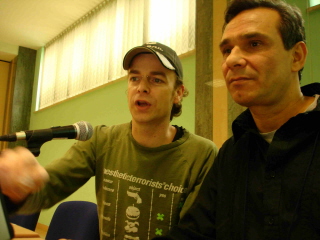Fighting Meth With Misinformation in Idaho
There is no question that methamphetamine is a potentially dangerous drug. Communities that take steps to prevent people from starting to use it in the first place are to be lauded. But if such efforts are to be credible with their target audiences, they need to include accurate information, not scary, demonizing distortions.
Unfortunately, Blaine County, Idaho, is not doing that. In a new brochure from the Blaine County Sheriff's Office and the Community Drug Coalition written by a sheriff's office employee, comes the following amazing claim:
"One of the biggest dangers of meth is how quickly people can become addicted to it," the brochure says. "The National Methamphetamine Awareness Campaign says that 99 percent of people are hooked on meth after using it the first time."Oh, come on. Yes, people can become dependent on meth. Yes, it is a drug whose biopharmacological effects make people want to binge on it. But no, 99% of people who try meth once are not hooked on it. And spewing such garbageâat taxpayer expense, no less!âis counterproductive at best. Here's what the federal government's meth resources web page has to say about methamphetamine addiction: "Long-term methamphetamine abuse results in many damaging effects, including addiction." Note that the site says long-term use, not one-time use. Neither do other federal government statistics back up the 99% claim. The 2005 National Survey on Drug Use and Health, the most recent available, notes that 10.4 million people over the age of 12 reported using meth at least once in their lives, but only 512,000 reported current (last month) use. Even if we assume that everyone who reported using within the last month is an addict (and that's not a very reasonable assumption), we find that only about 5% of people who ever used meth are currently addicted. It is possible, I suppose, that the remaining 93% of all meth users ever got strung out on their first line, but have since managed to beat the addiction. If that's the case, which I doubt, they didn't get the monkey off their backs through drug treatment. In 1992, 21,000 were admitted for meth treatment; by 2004, that number was up to 150,000. But the number of people reporting using meth that year was 1.3 million. Of past year meth users, a little more than 10% got treatment in 2004, whether they sought it themselves or were forced into it. If you want to discourage people from using meth, you need to be believable. Unfortunately for Blaine County, Idaho, it has produced an anti-meth brochure that is more laughable than believable. Next they'll be telling me meth will make hair grow on the palms of my hands.
Congressional Staff Briefing (Senate): Reforming Crack Cocaine Sentencing
On May 15, the United States Sentencing Commission (USSC) updated its 2002 Report to Congress on Federal Cocaine Sentencing. The USSC report once again finds that there is no rationale for the sentencing differences between the two forms of the drug. Under current law, possessing or selling 5 grams of crack cocaine results in the same five-year mandatory minimum sentence as selling 500 grams of powder cocaine. The law harshly punishes low-level offenders, and has had a disparate impact on African-American and low-income communities. Join us in a frank discussion on avenues for reform of this unjust law.
Congressional Staff Briefing (House): Reforming Crack Cocaine Sentencing
On May 15, the United States Sentencing Commission (USSC) updated its 2002 Report to Congress on Federal Cocaine Sentencing. The USSC report once again finds that there is no rationale for the sentencing differences between the two forms of the drug. Under current law, possessing or selling 5 grams of crack cocaine results in the same five-year mandatory minimum sentence as selling 500 grams of powder cocaine. The law harshly punishes low-level offenders, and has had a disparate impact on African-American and low-income communities. Join us in a frank discussion on avenues for reform of this unjust law.
Allan Clear Reports from the International Harm Reduction Conference in Warsaw
(DRCNet is pleased to welcome Allan Clear, executive director of the Harm Reduction Coalition, as a special guest correspondent for the Stop the Drug War Speakeasy. Allan is currently in Warsaw, Poland, attending the 18th International Conference on the Reduction of Drug Related Harm, and has graciously agreed to report for us on the proceedings. He has come through with photos and all. Because I was offline most of the last few days, Allan's first few posts are all coming out together in one. Any subsequent posts from the conference will come out one by one. Here Allan writes about getting to the place, the place, pre-conference meetings of the International Network of People Who Use Drugs and various satellite groups, and the conference's first day. - DB)
 Allan Clear
Allan Clear
 Stijn Goossens & Luiz Paolo Guanabara, at the conference
(Click the "read full post" link below or here to read Allan's full reports, with more pictures.)
Stijn Goossens & Luiz Paolo Guanabara, at the conference
(Click the "read full post" link below or here to read Allan's full reports, with more pictures.)
 Allan Clear
Allan Clear
 Stijn Goossens & Luiz Paolo Guanabara, at the conference
(Click the "read full post" link below or here to read Allan's full reports, with more pictures.)
Stijn Goossens & Luiz Paolo Guanabara, at the conference
(Click the "read full post" link below or here to read Allan's full reports, with more pictures.)